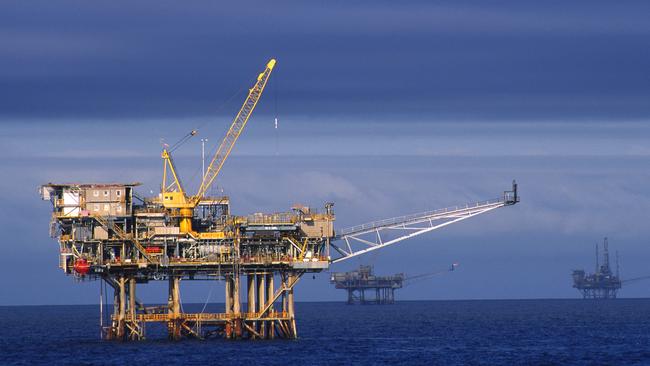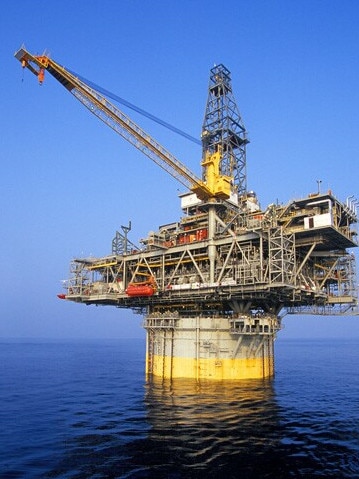ExxonMobil faces $2bn Bass Strait clean-up bill
Oil and gas production has already stopped at over half ExxonMobil’s 400-plus Bass Strait wells, with a hefty decommissioning bill looming.

Business
Don't miss out on the headlines from Business. Followed categories will be added to My News.
ExxonMobil faces a crackdown from the national environmental regulator over its ageing Bass Strait oil and gas fields offshore Victoria after being ordered to seal 180 wells and dismantle 10 platforms by 2027, underlining mounting concern over $50bn industry-wide clean-up bill.
The US oil giant submitted a revised environmental plan for decommissioning its sprawling oil and gas infrastructure which have been in production since 1969. However, the regulator issued a broader direction to its Australian arm Esso and asked it to consider accelerating the timeline for the mammoth decommissioning task. Exxon’s overall Bass Strait clean-up bill will likely cost more than $US2bn ($2.6bn), according to Credit Suisse.
“Esso has a large number of assets not in use or soon to cease being used for production and this will be the first time decommissioning on this scale has been undertaken in Australia. Nopsema will be closely monitoring Esso’s progress under the direction, ”the National Offshore Petroleum Safety and Environmental Management Authority said in a statement.

The issue of abandonment liabilities has caused considerable tension in Australia’s oil and gas sector after the Morrison government proposed a $250m-plus industry levy to fund the clean-up of the Northern Endeavour floating platform and associated oilfields in the Timor Sea.
Pressure is growing for the regulator to flex its power and ensure the industry meets targets and has enough funding while ensuring taxpayers are not left on the hook for any clean-up costs.
The regulator’s demands are significant as they represent a new focus by the regulator, Credit Suisse said.
“There is now far greater political scrutiny over decommissioning in the wake of the NOGA debacle, and we are seeing a new more stringent focus by the regulator to hasten otherwise laggard decommissioning activity to more rigorous standards,” Credit Suisse analyst Saul Kavonic said.

Oil and gas production has already stopped at over half of Exxon’s 421 Bass Strait wells drilled with the regulator anxious to ensure the hefty decommissioning bill is addressed.
“It is Nopsema’s view that Esso’s ability to decommission appropriately is increasingly at risk the longer the period that elapses between cessation of production and completion of decommissioning activities. Further it is Nopsema’s view that risk to safety of people at facilities and environmental risks and impacts are also observed to be increasingly challenging to manage the longer non-producing facilities remain,” the regulator said.
“Nopsema is of the opinion that while Esso has provided an overview of the decommissioning activities proposed, the level of planning and timing proposed for removal is not commensurate with the scale of decommissioning activities required.”
Exxon has also been hit with “improvement notices” to immediately address identified corrosion issues on the Tuna and West Tuna facilities due to the potential risk posed to workers.
The energy major said it was committed to its decommissioning responsibilities.
“Our detailed planning is well underway and we have already started much of the early work required – over the past two years we have invested more than $300m to plug and abandon wells at Mackerel, Blackback and Whiting,” an Exxon spokesman said. “Over the next two years we will spend more than $150m on further plug and abandonment work, including the recent introduction of a second platform based rig into the Gippsland Basin.”
Uncertainty also swirls over whether Exxon and its joint venture partner, BHP, will remain long-term owners of the fields and assets.
Exxon opened a sale in September 2019 of its Bass Strait interests and then abandoned the process a year later while BHP has indicated it will sell its 50 per cent stake as it seeks to refresh its petroleum division.
Gas producer Woodside Petroleum previously owned the Northern Endeavour project before selling the facility to NOGA in July 2015. NOGA subsequently fell into liquidation, raising concern about who pays for abandoned facilities if companies go bust.
Nopsema hinted it would not let a similar scenario play out in one of the nation’s biggest oil and gas provinces.
“BHP has informed Nopsema that it intends to sell its interests in the Bass Strait offshore operations titles. Although such a company sale may not alter the title register, it is important for transparency that all parties understand the obligations imposed under the Offshore Petroleum and Greenhouse Gas Storage Act 2006,” Nopsema said.
New trailing liability rules for decommissioning of old assets allow the government to hold the previous owners of the oil or gas projects to account for decommissioning work.
Some $52bn of decommissioning work on Australia’s offshore oil and gas infrastructure needs to be completed with over half to be started within the next ten years, a study commissioned by National Energy Resources Australia found in March.



